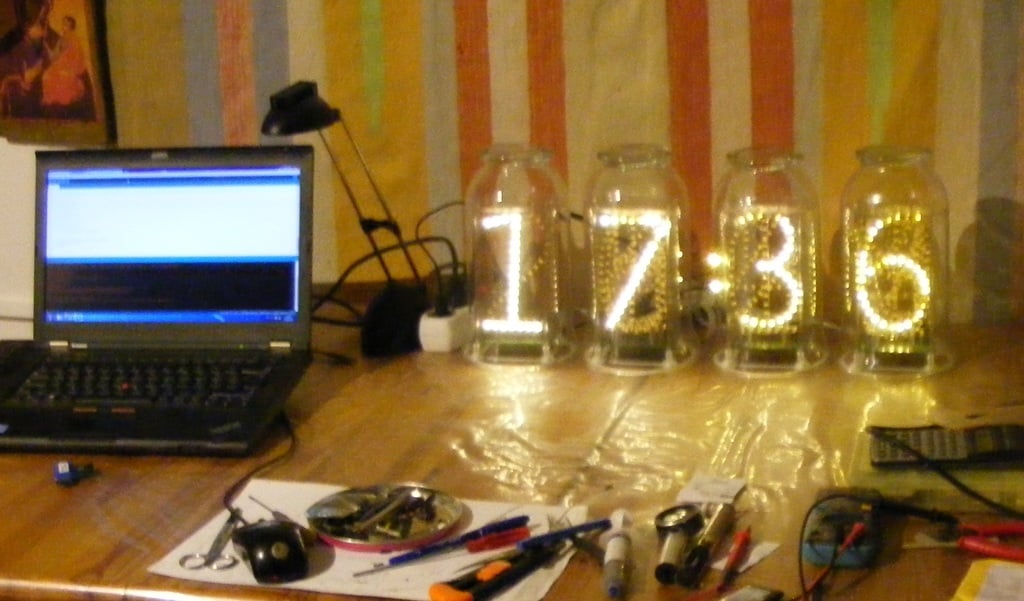
LED Nixie clock, giant tube
thingiverse
The project Giant Size LED Nixie Clock demands unwavering patience and determination, particularly when crafting the 28 digits with nearly 1000 LEDs. However, the end result is breathtakingly stunning. The LEDs arranged in a 1970s nixie look within a glass enclosure perfectly blend old-fashioned charm with modern sophistication. Assembling one digit requires meticulous attention to detail: Begin by printing the digits in size 140 x 75 mm in mirror image and glue them onto strong cardboard. Bend the tab wire according to the digit's shape on the outside, securing it through perforated holes so that it retains its shape while soldering the LEDs to it. Solder the LED cathodes equally at 1 cm distance from the tab wire, positioning the LED anode in the digit's center direction with the light-emitting side facing the cardboard. Use solder flux and work quickly, as excessive heat can damage the SMD LEDs. Solder the anode wire (bare copper 0.4-0.5 mm) to each LED as well as to the inside of the digit. With all LEDs soldered, a rigid structure will form. Next, solder the support wires (1mm bare copper) to the digit, placing one or two on the bottom and one or two on the top side 40mm apart. Then, solder the digit to the PCB at 5 or 7.5 mm intervals. My arrangement is 0-1-7-2-3-4-5-6-8-9 (though I'm not sure if this is the most efficient configuration), and in general, the digits at the front cover those in the back. Don't worry; all digits will be incredibly bright even so (note: brightness is software adjustable). With all digits in place, solder bridges between the digit cathode wires on the outside where possible to strengthen the assembly. All cathodes are electrically parallel connected anyway. To create the clock's functionality: Minutes and hours require 0-9 digits, while 10 minutes demand 0-5 digits, and 10 hours need 1,2 if you don't want a leading zero. A total of 28 digit frames will be needed. Once all four assemblies are ready: Follow the LED driver schematics and place the digit driver components on the PCB's bottom surface. The cable running to the microcontroller should consist of GND, +5V, some 5 signals to HC138, and 350/700 mA total current select to L7135. I used a 10-wire flat cable with power on double wires. One digit contains the colon with its driver as well. The microcontroller can be any type, but I used the STM32 for this project. Driving the digits requires at least 14 digital outputs, one PWM (or four if you want to drive all LED chips equally bright), i2C for the clock chip, and four digital inputs for brightness control. A microcontroller running on 3.3v like the STM32 has no problem driving the 74HC138 chips which run on 5V. In my prototype, the port arrangement is as follows: Minutes: 17,18,19,20 (bit weights: see program list) 10 minutes: 12,13,14 Hours: 28,29,30,31 10 hours: 21,22 PWM outputs per digit to HC138: 27,26,3,4 Decimal point/colon: 25 Code switch inputs: 0,1,5,6 Please see the zip-ed photos for more details. Material list: 5730 LED 0.5W warm white (30-35 per digit x 28 numbers = 1000 pcs) Tab wire 2mm 30m (100 ft), solder flux RMA-218 Plexi or polycarbonate 1.5-2 mm sheet 117mm dia 4pcs, 180x80 8pcs PCB universal glassfiber 7x9 cm 4pcs 74HC138 16 pcs, P-MosFet 40 pcs L7135 8 pcs STM32 Blue Pill or similar, DS3231 Clock module, 5V 2A power supply Glass vase, straight, 12cm dia, 20cm high approx. (IKEA) 4pcs. Redesign file nixie base.stl to fit.
With this file you will be able to print LED Nixie clock, giant tube with your 3D printer. Click on the button and save the file on your computer to work, edit or customize your design. You can also find more 3D designs for printers on LED Nixie clock, giant tube .
